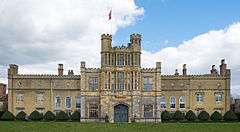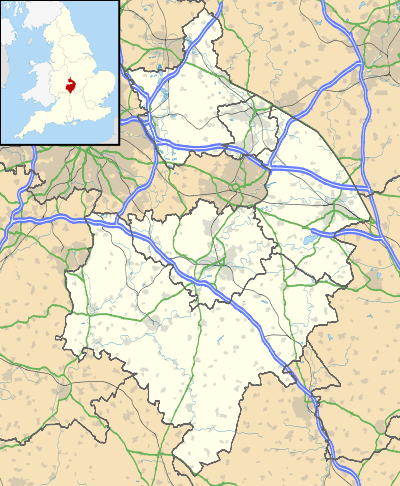Coughton Court
Coughton Court /ˈkoʊtən/[1] (grid reference SP080604) is an English Tudor country house, situated on the main road between Studley and Alcester in Warwickshire. It is a Grade I listed building.
| Coughton Court | |
|---|---|
 Coughton Court | |
 Location within Warwickshire | |
| General information | |
| Type | Stately home |
| Location | Warwickshire |
| Coordinates | 52.2435°N 1.880°W |
| Completed | Built c.16th century |
| Owner | in the care of the National Trust |
| Website | |
| https://www.coughtoncourt.co.uk/ | |
The house has a long crenelated façade directly facing the main road, at the centre of which is the Tudor Gatehouse, dating from 1530; this has hexagonal turrets and oriel windows in the English Renaissance style. The gatehouse is the oldest part of the house and is flanked by later wings, in the Strawberry Hill Gothic style, popularised by Horace Walpole.
History
The Coughton estate has been owned by the Throckmorton family since 1409. The estate was acquired through marriage to the De Spinney family.[2] Coughton was rebuilt by Sir George Throckmorton, the first son of Sir Robert Throckmorton of Coughton Court by Catherine Marrow, daughter of William Marrow of London.[2] The great gatehouse at Coughton was dedicated to King Henry VIII by Throckmorton, a favourite of the King.[2] Throckmorton would become notorious due to his almost fatal involvement in the divorce between King Henry and his first wife Catherine of Aragon.[2] Throckmorton favoured the queen and was against the Reformation. Throckmorton spent most of his life rebuilding Coughton.[3] In 1549, when he was planning the windows in the great hall, he asked his son Nicholas to obtain from the heralds the correct tricking (colour abbreviations) of the arms of his ancestors' wives and his own cousin and niece by marriage Queen Catherine Parr[3] (see gallery drawing). The costly recusancy (refusal to attend Anglican Church services) of Robert Throckmorton and his heirs restricted later rebuilding, so that much of the house still stands largely as he left it.[3]
After Throckmorton's death in 1552, Coughton passed to his eldest son, Robert. Robert Throckmorton and his family were practicing Catholics therefore the house at one time contained a priest hole, a hiding place for priests during the period when Catholics were persecuted by law in England, from the beginning of the reign of Elizabeth I of England. The Hall also holds a place in English history for its roles in both the Throckmorton Plot of 1583 to murder Queen Elizabeth, and the Gunpowder Plot of 1605, although the Throckmorton family were themselves only indirectly implicated in the latter, when some of the Gunpowder conspirators rode directly there after its discovery.
The house has been in the ownership of the National Trust since 1946. The family, however, hold a 300-year lease and previously managed the property on behalf of the Trust. In 2007, however, the house reverted to management by the National Trust. The management of the property is renewed every 10 years. The family tenant was Clare McLaren-Throckmorton, known professionally as Clare Tritton QC, until she died on 31 October 2017.[4]
The house, which is open to the public all year round, is set in extensive grounds including a walled formal garden, a river and a lake.
Architecture
The gatehouse at Coughton was built at the earliest in 1536, as it is built of stones which came from Bordesley Abbey and Evesham Abbey after the Dissolution of the Monasteries Act in 1536. As with other Tudor houses, it was built around a courtyard, with the gatehouse used for deliveries and coaches to travel through to the courtyard.[5] The courtyard was closed on all four sides until 1651, when Parliamentary soldiers burnt the fourth (east) wing, along with many of the Throckmorton's family papers, during the English Civil War.
After the Roman Catholic Relief Act was passed in 1829, the Throckmorton family were able to afford large-scale building works, allowing them to remodel the west front.
In popular culture
The house was used as a filming location for the BBC One series Father Brown in the episode The Mask of the Demon.[6]
Gallery
 Coughton Court in the late 19th century
Coughton Court in the late 19th century Coughton Court courtyard
Coughton Court courtyard Coughton Court gatehouse
Coughton Court gatehouse Coughton Court facade
Coughton Court facade.jpg) Armorials depicted in windows of Coughton Court, by Wenceslaus Hollar (d. 1677)
Armorials depicted in windows of Coughton Court, by Wenceslaus Hollar (d. 1677) Old Buildings in Coughton Courtyard
Old Buildings in Coughton Courtyard
See also
- Hampton Court Palace
- Throckmorton Baronets
References
- "The House at Coughtoncourt.co.uk/". Archived from the original on 2011-06-23. Retrieved 2010-09-19.
- Peter Marshall. Catholic Gentry in English Society: The Throckmortons of Coughton from Reformation to Emancipation, Ashgate Publishing, Ltd., Nov 17, 2009. Google eBook
- The History of Parliament: the House of Commons 1509-1558, ed. S.T. Bindoff, 1982. Article: THROCKMORTON, Sir George (by 1489-1552), of Coughton, Warws.
- Guy Tritton (22 November 2017). "McLaren-Throckmorton". The Daily Telegraph. Retrieved 28 November 2017.
- http://www.britishlistedbuildings.co.uk/en-305306-coughton-court-coughton-warwickshire#.VTQTCs6ghUQ
- https://www.imdb.com/title/tt4860336/
- Styles, Philip, ed. (1945). 'Parishes: Coughton', A History of the County of Warwick, Volume 3. Courtesy of British History Online. pp. 74–86.
- Coughton Court (1979) Booklet for National Trust by J Lees-Milne.
- "Six centuries in the same house". Daily Telegraph. 5 September 2009.